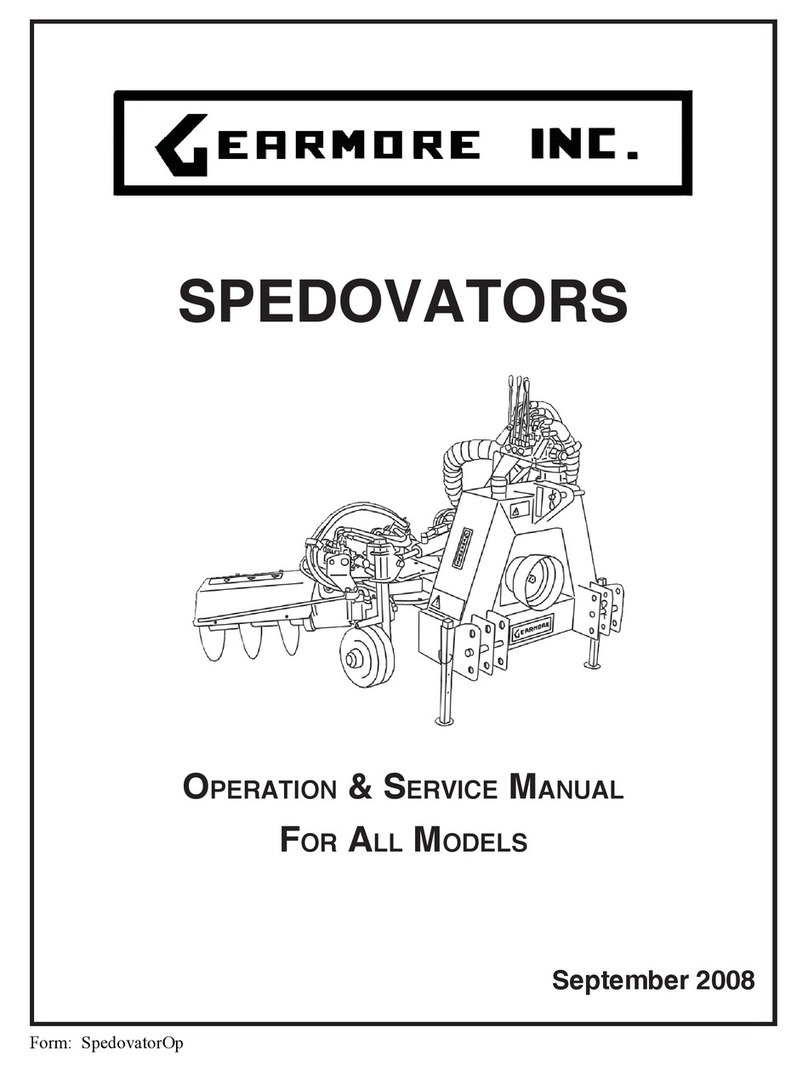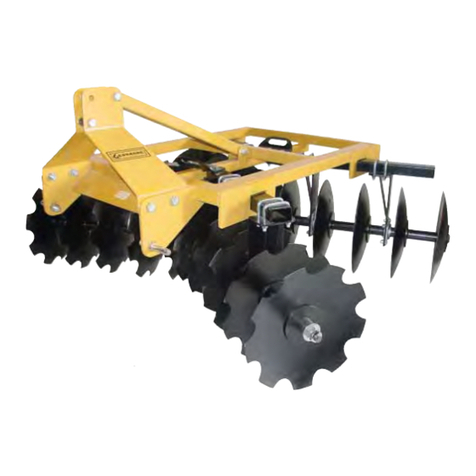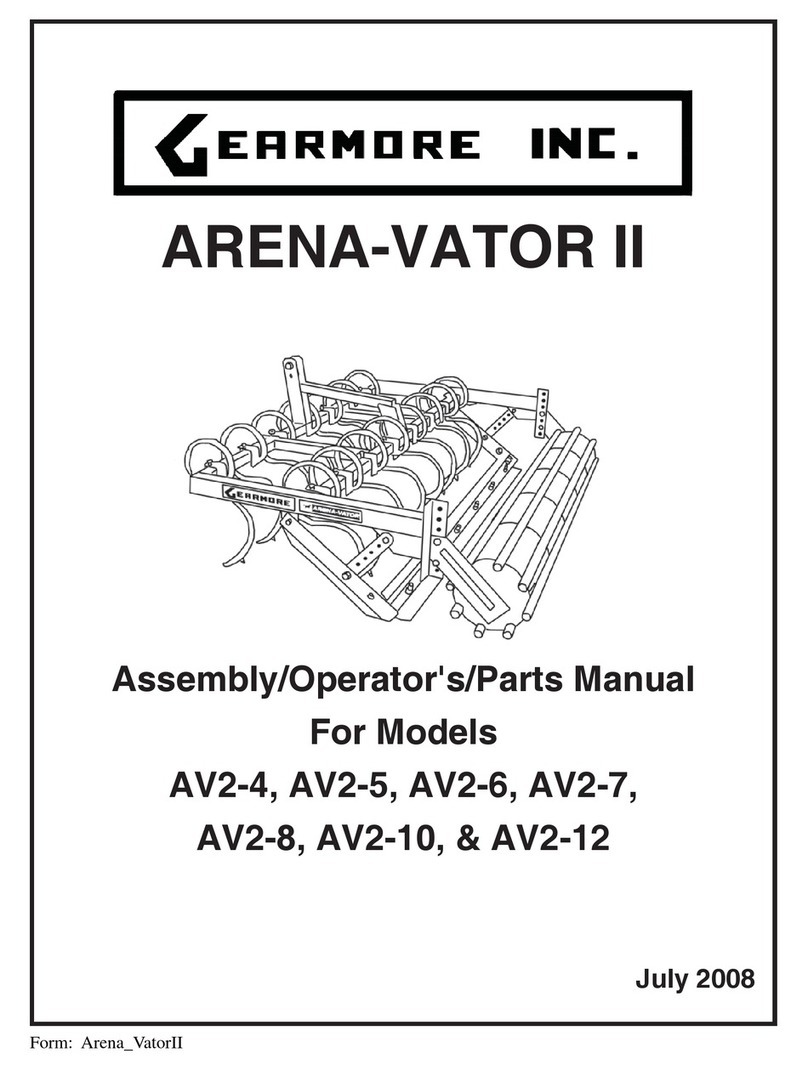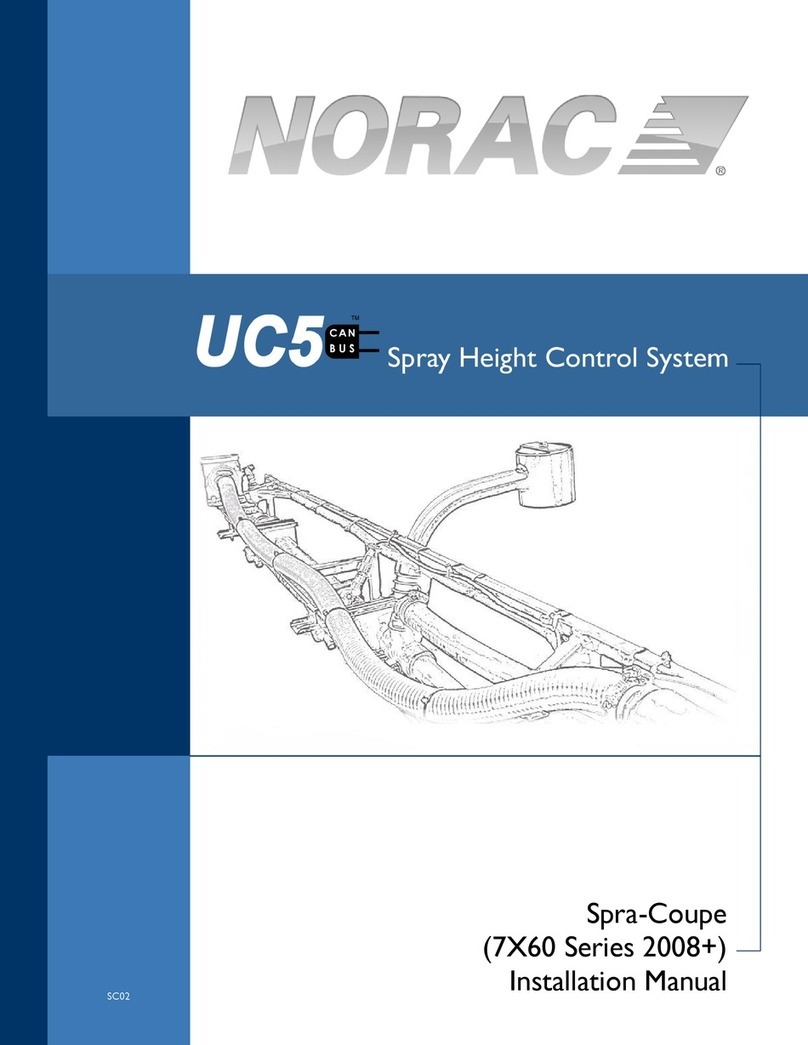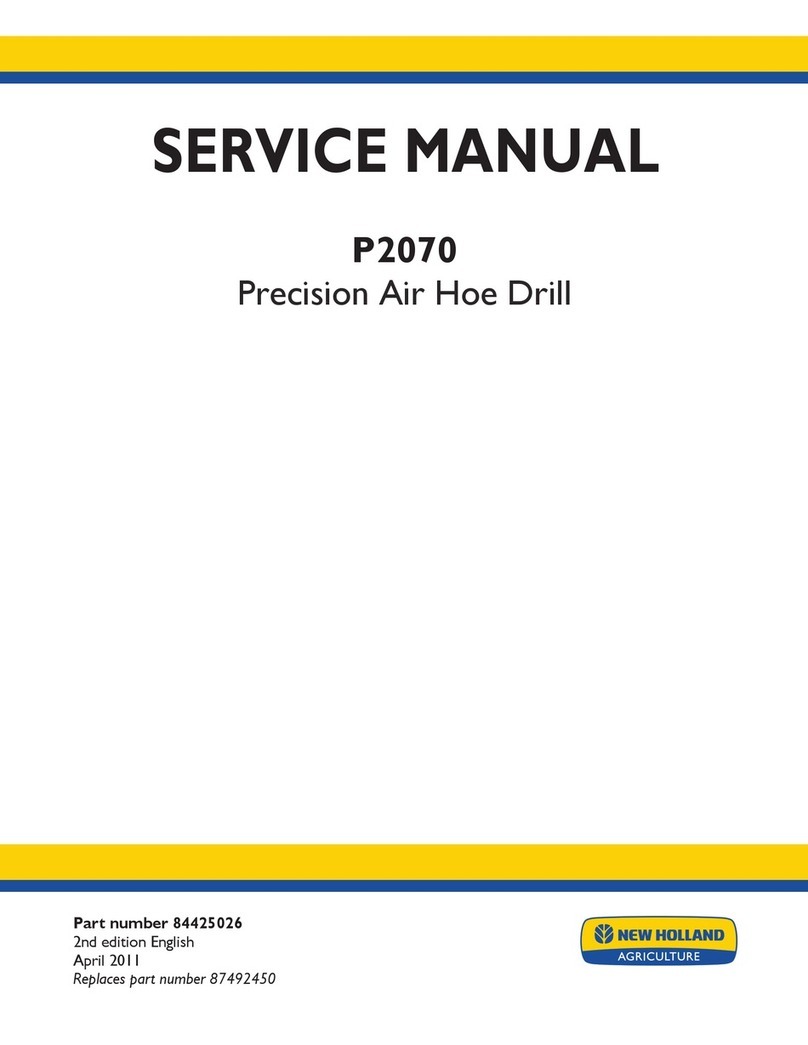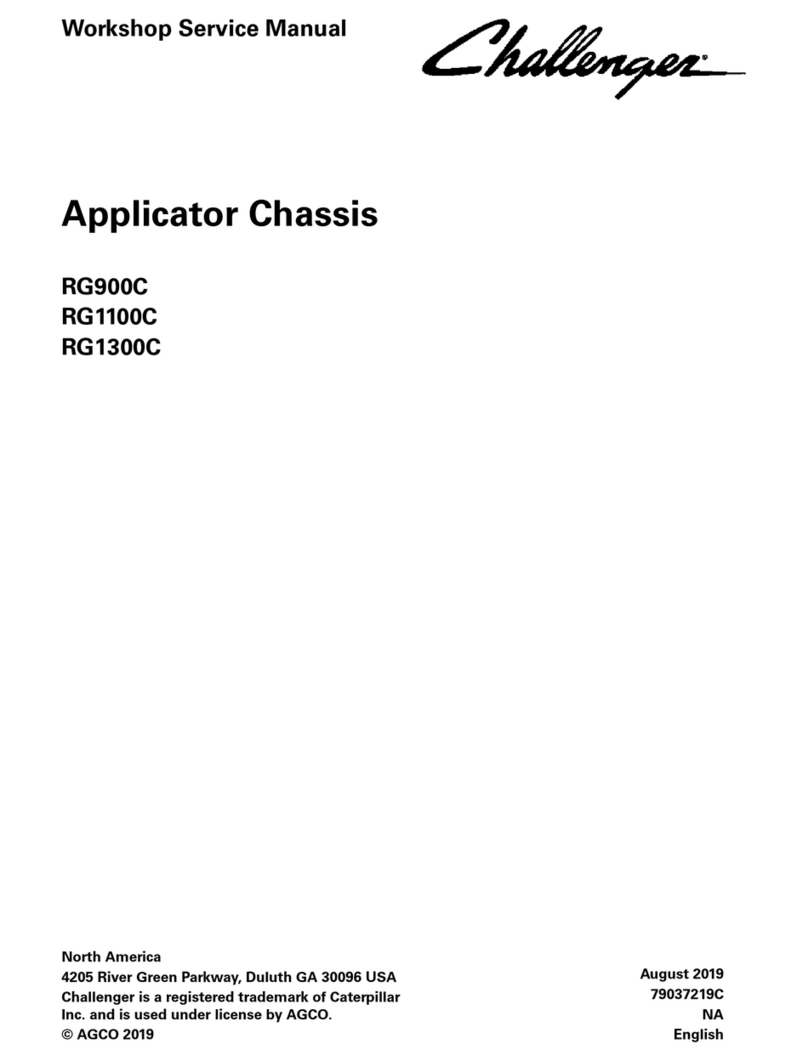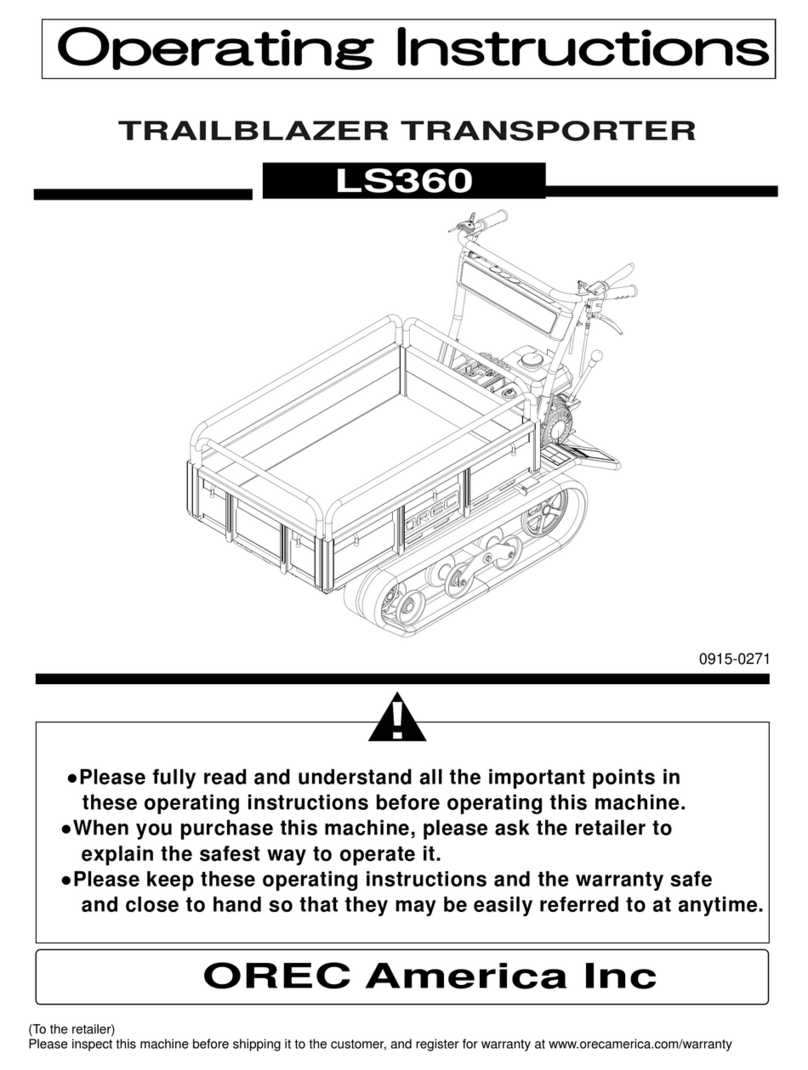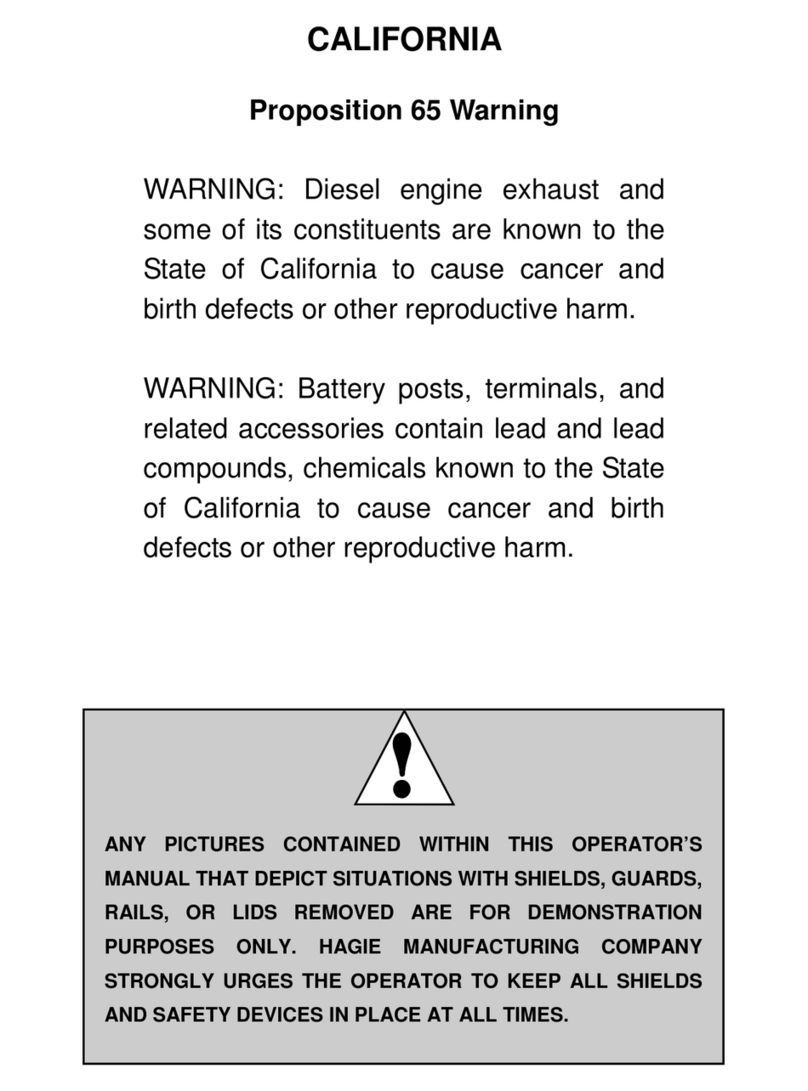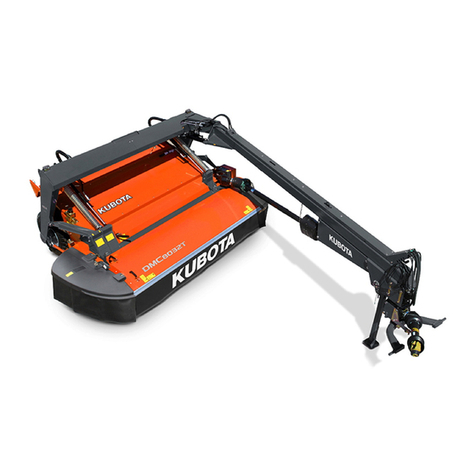Gearmore T1618 User manual

TANDEM
DISCS
Assembly/Operator's
Manual For Models
T1618, T2018
& T2418
October 2015
Form: TandemDiscRev.indd

TABLE OF CONTENTS
SECTION DESCRIPTION PAGE
1 Introduction .............................................................. 1
1.1 Serial Number Location .......................................... 1
2 Safety............................................................................ 2
2.1 General Safety ......................................................... 3
2.2 Equipment Safety Guidelines ................................. 4
2.3 Safety Training ........................................................ 5
2.4 Safety Signs ............................................................. 5
2.5 Preparation .............................................................. 6
2.6 Operating Safety...................................................... 7
2.7 Transport Safety...................................................... 8
2.8 Maintenance Safety................................................. 8
2.9 Hydraulic Safety ...................................................... 9
2.10 Storage Safety.......................................................... 9
3 Operation .................................................................. 10
3.1 To the New Operator or Owner ............................ 10
3.2 Machine Components ............................................ 11
3.3 Pre-Operation Checklist........................................ 13
3.4 Preparation of Tractor........................................... 13
3.5 Field Operation...................................................... 14
3.6 Disc Angle Adjustment.......................................... 15
3.7 Maintenance........................................................... 15
3.8 Transporting .......................................................... 16
3.9 Storage ................................................................... 16
4 Trouble Shooting..................................................... 17
5 Assembly.................................................................... 18
6 Specifications ........................................................... 19
6.1 Mechanical ............................................................. 19
6.2 Bolt Torque............................................................. 19
7 Limited Warranty.................................................... 20

1 INTRODUCTION
Congratulations on your choice of Tandem Discs.
Safe, efficient and trouble free operation of your Tandem Discs requires that you and anyone else who will be
operating or maintaining the machine, read and understand the Safety, Operation, Maintenance and Trou-
bleshooting information contained within the Operator's Manual.
This manual covers the Tandem Disc Models T1618, T2018 & T2418. Differences are explained where ap-
propriate. Use the Table of Contents as a guide to locate required information.
Keep this manual handy for frequent reference and to pass on to new operators or owners. Call your Gear-
more dealer or distributor if you need assistance, information or additional copies of the manuals.
OPERATOR ORIENTATION - The directions left, right, front and rear, as mentioned throughout this manual,
are as seen from the driver's seat and facing in the direction of travel.
1
1.1 SERIAL NUMBER LOCATION
Always give your dealer the serial number of your Tandem Disc when ordering parts or requesting service or
other information.
The serial number plate is located where indicated. Please mark the number in the space provided for easy
reference.
DATE OFPURCHASE:___________________________
MODEL NUMBER:______________________________
SERIAL NUMBER:______________________________

2 SAFETY SAFETY ALERT SYMBOL
Why is SAFETY important to you?
The Safety Alert symbol identifies
important safety messages on the
Tandem Discs and in the manual.
When you see this symbol, be alert
to the possibility of personal injury
or death. Follow the instructions
in the safety message.
This Safety Alert symbol means
ATTENTION! BECOME
ALERT! YOUR SAFETY IS IN-
VOLVED!
3 Big Reasons
Accidents Disable and Kill
Accidents Cost
Accidents Can Be Avoided
DANGER - Indicates an imminently hazardous
situation that, if not avoided, will result
in death or serious injury. This signal
word is to be limited to the most
extreme situations typically for
machine components which, for
functional purposes, cannot be guarded.
WARNING - Indicates a potentially hazardous
situation that, if not avoided, could
result in death or serious injury, and
includes hazards that are exposed
when guards are removed. It may
also be used to alert against unsafe
practices.
CAUTION - Indicates a potentially hazardous
situation that, if not avoided, may
result in minor or moderate injury.
It may also be used to alert against
unsafe practices.
SIGNAL WORDS:
Note the use of the signal words DANGER,
WARNING and CAUTION with the safety
messages. The appropriate signal word for
each message has been selected using the
following guide-lines:
SI NO LEE INGLES, PIDA AYUDA
A AIGUIEN QUE SI LO LEA PARA
QUE LE TRADUZCA LAS
MIDIDAS DE SEGURIDAD.
If you have any questions not answered in this manual or require additional copies or the manual is
damaged, please contact your dealer.
2

3
2.1 GENERAL SAFETY
YOU are responsible for the SAFE operation and
maintenance of your Tandem Disc. YOU must ensure
that you and anyone else who is going to operate,
maintain or work around the Disc be familiar with the
operating and maintenance procedures and related
SAFETY information contained in this manual. This
manual will take you step-by-step through your work-
ing day and alerts you to all good safety practices that
should be adhered to while operating the Disc.
Remember, YOU are the key to safety. Good safety
practices not only protect you, but also the people
around you. Make these practices a working part of
your safety program. Be certain that EVERYONE
operating this equipment is familiar with the recom-
mended operating and maintenance procedures and
follows all the safety precautions. Most accidents can
be prevented. Do not risk injury or death by ignoring
good safety practices.
Disc owners must give operating
instructions to operators or employees
before allowing them to operate the
machine, and at least annually there
after per OSHA (Occupational Safety and
Health Administration) regulation
1928.57.
The most important safety feature on this
equipment is a SAFE operator. It is the operator's
responsibility to read and understand ALL Safety
and Operating instructions in the manual and to
follow these. Most accidents can be avoided.
A person who has not read and understood
all operating and safety instructions
is not qualified to operate the machine.
An untrained operator exposes himself
and bystanders to possible serious injury
or death.
DO NOT modify the equipment in any
way. Unauthorized modification may im-
pair the function and/or safety and could
affect the life of the equipment.
1. Read and understand the
Operator's Manual and all
safety signs before operating,
maintaining or adjusting the
Tandem Disc.
2. Have a first-aid kit available
for use should the need arise
and know how to use it.
3. Have a fire extinguisher
available for use should
the need arise and know
how to use it.
4. Wear appropriate protective
gear. This list includes but is
not limited to:
- A hard hat
- Protective shoes
with slip resistant
soles
- Protective goggles,
glasses or face
shield
- Heavy gloves
- Protective clothing
5. NEVER allow children to operate tractor
and Disc or other power equipment.
6. DO NOT allow riders.
7. Wear suitable ear protection
for prolonged exposure to
excessive noise.
8. Lower Tandem Disc to the ground, set
park brake, remove ignition key and wait
for all moving parts to stop before servicing,
adjusting and repairing.
9. Clear the area of people, especially small
children, before starting.
10. Review safety related items annually
with all personnel who will be operating
or maintaining the Tandem Disc.

2.2 EQUIPMENT SAFETY GUIDELINES
4
Safety of the operator and bystanders is one of the
main concerns in designing and developing a ma-
chine. However, every year many accidents occur
which could have been avoided by a few seconds of
thought and a more careful approach to handling
equipment. You, the operator, can avoid many
accidents by observing the following precautions
in this section. To avoid personal injury or death,
study the following precautions and insist those
working with you, or for you, follow them.
• In order to provide a better view, certain
photographs or illustrations in this manual
may show an assembly with a safety shield
removed. However, equipment should never
be operated in this condition. Keep all shields
in place. If shield removal becomes necessary
for repairs, replace the shield prior to use.
• Replace any safety sign or instruction sign
that is not readable or is missing. Location of
such safety signs is indicated in this manual.
• NEVER use alcoholic beverages or drugs
which can hinder alertness or coordination
while operating this equipment. Consult your
doctor about operating this machine while
taking prescription medications.
• Under no circumstances should young
children be allowed to work with this
equipment. Do not allow persons to
operate or assemble this unit until they
have read this manual and have devel-
oped a thorough understanding of the
safety precautions and of how it works.
Review the safety instructions with all users
annually.
• This equipment is dangerous to children and
persons unfamiliar with its operation. The op-
erator should be a responsible, properly trained
and physically able person familiar with farm
machinery and trained in this equipment's
operations. If the elderly are assisting with
farm work, their physical limitations need to be
recognized and accommodated.
• Use a tractor equipped with a Roll Over Protec-
tive Structure (ROPS) and a seat belt.
• NEVER exceed the limits of a piece of machin-
ery. If its ability to do a job, or to do so safely, is
in question - DON'T TRY IT.
• Do not modify the equipment in any way. Un-
authorized modification may impair the func-
tion and/or safety and could affect the life of the
equipment.
In addition to the design and configuration of this
implement, including Safety Signs and Safety Equip-
ment, hazard control and accident prevention are
dependent upon the awareness, concern, prudence
and proper training of personnel involved in the op-
eration, transport, maintenance and storage of the
machine. Refer also to Safety Messages and operation
instruction in each of the appropriate sections of the
tractor and machine manuals. Pay close attention
to the Safety Signs affixed to the tractor and the
machine.
Think SAFETY! Work SAFELY!

2.3 SAFETY TRAINING
Safety is a primary concern in the design and manu-
facture of our products. Unfortunately, our efforts to
provide safe equipment can be wiped out by a single
careless act of an operator or bystander.
In addition to the design and configuration of equip-
ment, hazard control and accident prevention are
dependent upon the awareness, concern, prudence
and proper training of personnel involved in the
operation, transport, maintenance and storage of
this equipment.
It has been said, "The best safety feature is an
informed, careful operator." We ask you to be
that kind of an operator. It is
the operator's responsibility to
read and understand ALL
Safety and Operating instructions
in the manual and to follow these. Accidents can be
avoided.
Working with unfamiliar equipment can lead to
careless injuries. Read this manual, and the manual
for your tractor, before assembly or operating, to ac-
quaint yourself with the machines. If this machine is
used by any person other than yourself, or is loaned
or rented, it is the machine owner's responsibility to
make certain that the operator, prior to operating:
a. Reads and understands the operator's
manuals.
b. Is instructed in safe and proper use.
Know your controls and how to stop tractor, engine
and machine quickly in an emergency. Read this
manual and the one provided with your tractor.
Train all new personnel and review instructions
frequently with existing workers. Be certain only
a properly trained and physically able person will
operate the machinery. A person who has not read
and understood all operating and safety instructions
is not qualified to operate the machine. An untrained
operator exposes himself and bystanders to possible
serious injury or death. If the elderly are assisting
with farm work, their physical limitations need to
be recognized and accommodated.
2.4 SAFETY SIGNS
1. Keep safety signs clean and legible at all times.
2. Replace safety signs that are missing or have
become illegible.
3. Replaced parts that displayed a safety sign
should also display the current sign.
4. Safety signs are available from your authorized
dealer or from Gearmore.
How To Install Safety Signs:
• Be sure that the installation area is clean
and dry.
•Be sure temperature is above 50ºF (10ºC).
•Determine exact position before you remove
the backing paper. (See Section 3)
•Remove the smallest portion of the split
backing paper.
•Align the sign over the specified area and
carefully press the small portion with the
exposed sticky backing in place.
•Slowly peel back the remaining paper and
carefully smooth the remaining portion of the
sign in place.
•Small air pockets can be pierced with a pin and
smoothed out using the piece of sign backing
paper.
5

2.5 PREPARATION
6
1. Never operate the tractor and machine until
you have read and completely understand
this manual, the Tractor Operator's Manual
and each of the Safety Messages found on
the safety signs on the tractor and machine.
2. Personal
protection
equipment,
including hard
hat, safety
glasses, safety
shoes and gloves
are recommended
during assembly,
installation, operation, adjustment,
maintaining, repairing, removal or moving
the implement. DO NOT allow long hair,
loose fitting clothing or jewelry to be around
equipment.
3. PROLONGED EXPOSURE
TO LOUD NOISE MAY
CAUSE PERMANENT
HEARING LOSS!
Tractors with or without
equipment attached can
often be noisy enough to cause permanent,
partial hearing loss. We recommend that
you wear hearing protection on a full-time
basis if the noise in the Operator's position
exceeds 80db. Noise over 85db on a long-
term basis can cause severe hearing loss.
Noise over 90db adjacent to the Operator
over a long-term basis may cause perma-
nent, total hearing loss. NOTE: Hearing
loss from loud noise (from tractors, chain
saws, radios, and other such sources close
to the ear) is cumulative over a lifetime
without hope of natural recovery.
4. Operate the machine only
with a tractor equipped
with an approved Roll-Over
Protective Structure (ROPS).
Always wear your seat belt.
Serious injury or even death
could result from falling off
the tractor --- particularly during a turn-
over when the operator could be pinned
under the ROPS or the tractor.
5. Clear working area of stones, branches
or hidden obstacles that might be hooked
or snagged, causing injury or damage.
6. Keep disc away from overhead
power lines. Electrocution can occur
without direct contact with an overhead
power line.
7. Operate only in daylight or good artificial
light.
8. Be sure machine is properly mounted,
adjusted and in good operating condition.
9. Before starting, give the machine a "once
over" for any loose bolts, worn parts,
cracks, leaks, frayed hoses and make
necessary repairs. Always follow
maintenance instructions.
10. Ensure that all safety shielding and
safety signs are properly installed and in
good condition.
11. Use caution when operating the tractor
on uneven terrain.
12. Move wheels or tires to their widest
position for maximum stability.
13. Decrease speed when making turns.
14. Use front and rear wheel weights as
required.
15. Add sufficient amount of weight to front
end of tractor to prevent wheels from
coming off the ground when starting
suddenly with a load.

2.6 OPERATING SAFETY
7
Please remember it is important that you read and
heed the safety signs on the tractor and disc. Clean
or replace all safety signs if they cannot be clearly
read and understood. They are there for your safety,
as well as the safety of others. The safe use of this
machine is strictly up to you, the operator.
All things with moving parts are potentially haz-
ardous. There is no substitute for a cautious, safe-
minded operator who recognizes potential hazards
and follows reasonable safety practices. The manu-
facturer has designed these Discs to be used with all
its safety equipment properly attached to minimize
the chance of accidents. Study this manual to make
sure you have all safety equipment attached.
Practice raising and lowering the disc when learning
to operate the Tandem disc. Become familiar with
controls before operating.
If a safety shield or guard is removed for any rea-
son, it must be replaced before the machine is again
operated.
Always operate disc with hitch hydraulic control
lever in lowered "float" position.
Do not operate near the edge of drop-offs or banks.
Do not operate at an angle on steep slopes. Drive
up or down but not across. Always lift disc before
turning at ends of field.
Make allowances for increased length and weight of
tractor during operation and moving.
Remove all sticks, stones, roots and wires from work-
ing area before starting. Take care not to contact
overhead obstructions during operation.
Never operate controls from the ground. Operate
only from the operators seat to prevent unexpected
movement that can lead to crushing between frame
members.
Start operation at a slower comfortable speed; in-
crease tractor speed as clods reduce size.
Keep disc away from overhead power lines. Elec-
trocution can occur without direct contact with an
overhead power line.
Never carry, lift or move people on disc. Do not use
machine as a work platform.
Always use two people to handle heavy, unwieldy
components during assembly, installation, removal
or moving.
Never place any part of your body where it would be
in danger if movement should occur during assem-
bly, installation, operation, maintaining, repairing,
removal or moving.
Do not walk or work under a raised machine or at-
tachment unless it is securely blocked or held in posi-
tion. Do not depend on the tractor hydraulic system
to hold the machine or attachment in place.
Never use alcoholic beverages or drugs, which can
hinder alertness or coordination, while operating
this equipment. Consult your doctor about operat-
ing this machine while taking prescription medica-
tions.
Do not allow riders on the machine or tractor at any
time. There is no safe place for any riders.
Do not go under raised disc. Keep others away.
Add sufficient amount of weight to front end of trac-
tor to prevent wheels from coming off the ground
when starting suddenly with a load.
Always remove the key when leaving the tractor
unattended.
Never allow disc to be left in the "up" position when
unattended.
Before you operate the machine, check over all pins,
bolts and connections to be sure all are securely in
place. Replace any damaged or worn parts imme-
diately.
Review safety instructions annually.

8
2.7 TRANSPORT SAFETY
1. Comply with state and local laws governing
highway safety and movement of farm
machinery on public roads.
2. The use of flashing amber lights is
acceptable in most localities. However,
some localities prohibit their use. Local
laws should be checked for all highway
lighting and marking requirements.
3. At all times, when driving the tractor and
equipment on the road or highway under
20 mph (32 kph) use flashing amber
warning lights and a slow moving vehicle
(SMV) identification emblem. Do not exceed
20 mph (32 kph). Reduce speed on rough
roads and surfaces.
4. Keep tractor in gear to provide engine
braking when going downhill. Do not coast.
5. Plan your route to avoid heavy traffic.
6. Keep brake pedals latched together at all
times.
7. Do not drink and drive.
8. Be a safe and courteous driver. Always yield
to oncoming traffic in all situations,
including narrow bridges, intersections, etc.
Watch for traffic when operating near or
crossing roadways.
9. Turn into curves or go up or down hills only
at a low speed and at a gradual steering
angle. Make certain that at least 20% of the
tractor's weight is on the front wheels to
maintain safe steerage. Slow down on rough
or uneven surfaces.
10. Never allow riders on either tractor or
machine. Riders may obstruct the operator's
view. They could also be struck by foreign
objects or thrown from the machine.
2.8 MAINTENANCE SAFETY
1. Good maintenance is your responsibility.
Poor maintenance is an invitation to
trouble.
2. Follow good shop practices.
- Keep service
area clean
and dry.
- Be sure electrical
outlets and tools
are properly
grounded.
- Use adequate light
for the job at hand.
3. Make sure there is plenty of ventilation.
Never operate the engine in a closed
building. The exhaust fumes may cause
asphyxiation.
4. Before working on this machine, shut
off the engine, set the brakes and remove
the ignition key.
5. Never work under equipment unless it is
blocked securely.
6. Use personal protection devices such as eye,
hand and hearing protectors, when
performing any service or maintenance
work.
7. Where replacement parts are necessary for
periodic maintenance and servicing,
genuine factory replacement parts must be
used to restore your equipment to original
specifications. The manufacturer will not be
responsible for injuries or damages caused
by use of unapproved parts and/or
accessories.
8. A fire extinguisher
and first aid kit
should be kept
readily accessible
while performing
maintenance on
this equipment
9. Periodically tighten all bolts, nuts and
screws and check that all cotter pins are
properly installed to ensure unit is in a safe
condition.
10. When completing a maintenance or service
function, make sure all safety shields and
devices are installed before placing unit in
service.

2.9 HYDRAULIC SAFETY
9
2.10 STORAGE SAFETY
Make sure that all the components in the
hydraulic system are kept in good condition
and are clean.
Replace any worn, cut, abraded, flattened or
crimped hoses and metal lines.
Relieve pressure before working on
hydraulic system.
Do not attempt any makeshift repairs to the
hydraulic lines, fittings or hoses by using
tapes, clamps or cements. The hydraulic
system operates under extremely high
pressure. Such repairs will fail suddenly
and create a hazardous and unsafe
condition.
Wear proper hand and
eye protection when
searching for a high
pressure hydraulic
leak. Use a piece of wood
or cardboard as a
backstop instead of hands
to isolate and identify
a leak.
If injured by a concentrated high pressure
stream of hydraulic fluid, seek medical
attention immediately. Serious infection or
toxic reaction can develop from hydraulic
fluid piercing the skin surface.
Before applying pressure to the system,
make sure all components are tight and
that lines, hoses and couplings are not
damaged.
When disconnecting hydraulic lines, shut off
hydraulic supply and relieve hydraulic
pressure.
1. Store the unit in an area away from human
activity
2. Do not permit children to play on or around
the stored machine.
3. Store the unit in a dry, level area. Support
the frame with planks or blocks if required.
SAFETY RECAP
The manufacturer follows the general Safety Stand-
ards specified by the American Society of Agricul-
tural Engineers (ASAE) and the Occupational Safety
and Health Administration (OSHA). Anyone who
will be operating and/or maintaining the Tandem
Disc must read and clearly understand ALL Safety,
Operating and Maintenance information presented
in this manual.
Do not operate or allow anyone else to operate this
equipment until such information has been reviewed.
Annually review this information before the season
start-up.
Make these periodic reviews of SAFETY and OPERA-
TION a standard practice for all of your equipment.
We feel that an untrained operator is unqualified to
operate this machine.
Think SAFETY! Work SAFELY!

3 OPERATION
10
3.1 TO THE NEW OPERATOR
OR OWNER
Disc should run level when 3-point hitch is pre-
adjusted as recommended and disc blades are
running between 3" - 5" deep. Depth of cut will
vary depending on soil type, moisture content and
weight of implement. Start operation at a slower
comfortable speed; increase tractor speed as clods
reduce size. The types of soil, moisture and weight
on harrow will determine how many times you will
have to go back and forth to get the kind of seed
bed desired. For harder or dryer soils, additional
weight may be added to improve penetration.
Always operate disc with hitch hydraulic control
lever in lowered "float" position. Ridging, some-
times caused by rear outer discs, can be reduced or
eliminated by changing tractor speed, shortening
upper link, or a combination of both. Always lift
disc before turning at ends of field.
It is the responsibility of the owner or opera-
tor to read this manual and to train all other
operators before they start working with
the machine. Follow all safety instructions
exactly. Safety is everyone's business. By
following recommended procedures, a safe
working environment is provided for the
operator, bystanders and the area around
the worksite. Untrained operators are not
qualified to operate the machine.
Many features incorporated into this machine are
the result of suggestions made by customers like
you. Read this manual carefully to learn how to
operate the machine safely and how to set it to
provide maximum field efficiency. By following
the operating instructions in conjunction with a
good maintenance program, your Tandem Disc
will provide many years of trouble free service.
OPERATING SAFETY
1. Read Operator's Manual.
2. Lower disc to the ground, stop engine, set
park brake, remove ignition key and wait
for all moving parts to stop before servicing,
adjusting and repairing.
3. Do not carry people on disc or frame.
4. Add sufficient weight to front end of trac-
tor to prevent wheels from coming off the
ground when starting suddenly with a load.
5. Stay away from overhead power lines.
Electrocution can occur without direct con-
tact.
6. Use caution when operating the tractor on
uneven terrain. Decrease speed when mak-
ing turns. Use front and rear wheel weights
as required.
7. Use only with a unit with ROPS and a seat
belt.
8. Never allow disc to be left in the "up" posi-
tion when unattended.
9. Always remove the key when leaving the
tractor unattended.
10. Review safety instructions.

11
3.2 MACHINE COMPONENTS

12
REF. NO. QTY. PART NO. DESCRIPTION
1 1 800302 Disc Frame (T1618 & T2018)
1 1 800303 Disc Frame (T2418)
2 2 800106 Front Beam 24" (T1618 & T2018)
2 2 800108 Front Beam 40" (T2418)
3 2 800115 Rear Beam 30" (T1618 & T2018)
3 2 800113 Rear Beam 45" (T2418)
4 1 521102 Top Brace 2 x 2 x 32" (T1618 & T2018)
4 1 824104 Top Brace 2 x 2 x 37" (T2418)
5 1 800336 Front Hitch ASAE LH ¼"
6 1 800337 Front Hitch ASAE RH ¼"
7 2 800330 Beam Adj. Handle 2" Cntr. (T1618 & T2018)
7 2 800332 Beam Adj. Handle 3" Cntr. (T2418)
8 2 800331 Beam Adj. Plate 2" Cntr. (T1618 & T2018)
8 2 800333 Beam Adj. Plate 3" Cntr. (T2418)
9 16 800116 U-Bolt ½x 3 x 3
10 As Req'd 800136 Disc Blade 18" Plain
11 As Req'd 800139 Disc Blade 18" Notched
12 4 W208RRB5 Bearing
13 16 8W119 Flange
32 8W121 Bolt ½x 1 ¼
14 4 8W214 Bearing Hanger
15 8 830536 Spool 4 ½"
16 As Req'd 830538 Spool 1 ¾"
17 As Req'd 830539 Spool 7 ¾"
18 2 830540 Spool End Cap
19 2 800150 Reg. 1" Nut
20 2 800151 Jam Nut 1"
21 4 Obtain Locally 1" Flat Washer
23 2 500106 Hitch Pin Cat. 1
BOLT PACK (T1618, T2018 & T2418))
Containing:
6 ea. ½x 3 ½" Hex Head Bolts
3 ea. ¾x 3 ½" Hex Head Bolts
4 ea. ¾x 2" Hex Head Bolt
38 ea. ½" Hex Nuts
7 ea. ¾" Hex Nuts
38 ea. ½" Lock Washers
7 ea. ¾" Lock Washers

3.3 PRE-OPERATION CHECKLIST
Prior to use, it is recommended that the following
mechanical items be checked:
A. Daily Operation Checks:
1. Check all nuts, bolts and other fasteners.
Tighten to their specified torque level.
2. Clean the unit of dirt and trash to
minimize rusting and wear.
3. Inspect all bearings for wear. Replace any
worn out bearings.
4. Replace any decals that are worn or
damaged.
Efficient and safe operation of the Tandem Disc
requires that each operator reads and under-
stands the operating procedures and all related
safety precautions outlined in this section. A
pre-operation checklist is provided for the opera-
tor. It is important for both the personal safety
and maintaining the good mechanical condition
of the Tandem Disc that this checklist is fol-
lowed.
Before operating the machine and each time
thereafter, the following areas should be checked
off:
Use only an Agricultural tractor of the
appropriate horsepower on the machine.
Check that the Disc is properly attached
to the tractor.
Be sure extra weights are mounted on the
front end of the tractor to prevent wheels
from coming off the ground when starting
suddenly with a load.
Check all parts for damage. Repair or
replace as required.
Check for entangled material. Remove this
material.
IMPORTANT:
Torque disc gang axle nuts to 250 ft. lbs. after the
first initial 5 hours of operation. Failure to tighten
the axle nuts may result in the nut becoming loose
or lost resulting in possible damage to the axle and/
or disc gang.
3.4 PREPARATION OF TRACTOR
With the hitch in the lowered position, adjust lower
link arms (Ref. 1) until lower link ball ends (Ref.
2) are approximately 10" from ground.
Attach stabilizer chains (Ref. 3) to lower pin posi-
tion at tractor. DO NOT TIGHTEN. Attach disc to
lower links (Ref. 1) of hitch (inside pins for Category
"0", outside pins for Category "I") and secure with
spring pins.
Connect upper link (Ref. 4) of tractor hitch to the
mounting holes on upper part of main frame (use
lower holes for Category "0", top holes for Category
"I"). Secure with hitch pin and spring pin.
When using a tandem disc, place the hitch in "Float"
and adjust upper link (Ref. 4) so that the front and
rear gangs are on the ground.
Raise disc with lift and adjust stabilizer chains
(Ref. 3) to prevent side sway in the transport posi-
tion.
Be sure you read and understand the Opera-
tor's Instruction Manual.
13

14
3.5 FIELD OPERATION
OPERATING SAFETY
The disc should run level when 3-point hitch is
pre-adjusted as recommended and disc blades are
running between 3" to 5" deep. Depth of cut will
vary depending on soil type, moisture content and
weight of implement. Start working operation at a
slower comfortable speed; increase tractor speed
as clods reduce size. The types of soil, moisture
and weight on disc will determine how many
times you will have to go back and forth to get
the kind of seed bed desired. For harder or dryer
soils, additional weight may be added to improve
penetration. Always operate disc with hitch hy-
draulic control lever in lowered "float" position.
Ridging, sometimes caused by rear outer discs,
can be reduced or eliminated by changing tractor
speed, shortening upper link, or a combination
of both. Always lift disc before turning at ends
of field.
Each operator should review this section of the
manual at the start of the season and as often as
required to be familiar with the machine.
CAUTION!
Be careful when working with Disc blades, as
the edges are sharp. Wear gloves when working
around disc blades.
1. After initial adjustments have been made
and tractor is hooked up to Disc, you are
ready to start discing.
OPERATING SAFETY
1. Read Operator's Manual.
2. Lower tandem disc to the ground, stop
engine, set park brake, remove ignition key
and wait for all moving parts to stop before
servicing, adjusting and repairing.
3. Do not carry people on disc or frame.
4. Add weight to front of tractor to prevent
wheels from coming off the ground.
5. Stay away from overhead power lines. Elec-
trocution can occur without direct contact.
6. Use caution when operating on uneven ter-
rain. Decrease speed when making turns.
7. Use only with a unit with ROPS and a seat
belt.
8. Never allow disc to be left in the "up" position
when unattended.
9. Give complete undivided attention to the job
at hand.
10. Do not go under raised implement. Keep
others away.
2. Lower Disc to ground and start moving
forward. Your travel speed will be
determined by soil conditions. You may find
you want more or less angle on the discs to
do the job. Refer to Disc Gang Angle
Adjustment on page 15.
3. When turning, always lift implement up
out of ground.
CAUTION!
Damage to the disc can occur if it is not lifted out of
the ground before turning.
4. Do not disc in reverse (travel backwards).
The disc is designed for working the soil
while traveling forward only. Damage to
the harrow may occur. Recommended
procedure for corners or tight places is:
a. Lift unit up
b. Back up into corner or other tight areas
c. Lower disc to ground and proceed with
discing going forward
5. Do not cross a ditch at a 90°angle (straight
on). Damage to the disc and/or tractor may
occur while crossing at a 90°angle. Always
cross a ditch on a diagonal.
DITCH DITCH
RIGHT WRONG

Your Gearmore Disc has 3 angle settings. If you are
using your Disc in loose soil and it is digging too deep,
reduce the gang angle cut. If your disc is not digging
deep enough, increase the gang angle cut.
To adjust the gang angle cut, raise the Disc a few
inches off the ground and block it up. Loosen the hex
head bolts in each disc gang mounting bar, where it
mounts to the main frame. Remove the bolts from
the bar and move the gang to the front or back. Re-
install the bolts and tighten.
For better ground finish, angle the rear gangs at a
lesser angle than the front gangs.
3.6 DISC ANGLE ADJUSTMENT
15
IMPORTANT:
Always turn tractor key off and remove key before
performing any maintenance or adjustments on
Disc.
NOTE:
The more angle you have the more aggressive the
cut will be and the more horsepower will be required
to pull your unit.
NOTE:
The rear discs should be centered between the front
discs for optimum performance.
3.7
Proper service and adjustment is the key to long life
for any implement. With careful systematic inspec-
tions, you can avoid many costly repairs and down-
time.
Torque all nuts to the torque value listed on page 19
after the first initial 5 hours of field operation.
IMPORTANT:
Torque disc gang axle nuts to 250 ft. lbs. after the
first initial 5 hours of operation. Failure to tighten
the axle nuts may result in the nut becoming loose
or lost resulting in possible damage to the axle
and/or disc gang.
LUBRICATION
There are no parts on the disc that require lubrica-
tion.
Bearings are sealed for life and do not require
greasing.

16
3.8 TRANSPORTING
TRANSPORT SAFETY
3.9 STORAGE
1. Make sure you are in compliance with all
local regulations regarding transporting
equipment on public roads and highways
including lights, reflectors and the SMV.
2. Maximum transport speed for implement is
20 mph (32 kph). DO NOT EXCEED. Never
travel at a speed which does not allow
adequate control of steering and stopping.
Reduce speed on rough roads and surfaces.
3. Do not allow anyone to ride on the imple-
ment or tractor during transport.
4. Sudden braking can cause a towed imple-
ment to swerve and upset.
5. DO NOT tow a load that is more than double
the weight of the tractor.
1. Store the unit in an area away from human
activity.
2. Do not permit children to play on or around
the stored machine.
3. Store the unit in a dry, level area. Support
the frame with planks if required.
STORAGE SAFETY
When transporting the machine, review and fol-
low these instructions:
1. Be sure all bystanders are clear of the ma-
chine.
2. A safety chain will help control towed im-
plement should it separate from the tractor.
DO NOT use safety chain for towing.
3. Be sure you have installed extra weights on
the tractor if required.
4. Clean the SMV emblem, lights and reflec-
tors and be sure they are working. Comply
with all local regulations.
5. Carry implement low when moving or
transporting.
6. Stay away from overhead power lines. Elec-
trocution can occur without direct contact.
7. Be sure your machine can clearly be seen by
overtaking and oncoming traffic.
8. Do not allow riders.
9. Always use hazard flashers on the tractor
when transporting unless prohibited by law.
After the season's use, the machine should be
thoroughly inspected and prepared for storage.
Repair or replace any worn or damaged compo-
nents to prevent any unnecessary down time at
the start of next season. To insure a long, trou-
ble free life, this procedure should be followed
when preparing the unit for storage:
1. Clear the area of bystanders, especially
small children.
2. Thoroughly wash the machine using a pres-
sure washer to remove all dirt, mud, debris
and residue.
3. Inspect the Disc and frame for damage or
entangled material. Repair or replace dam-
aged parts. Remove all entangled material.
4. Touch up all paint nicks and scratches to
prevent rusting. Spray the cutting blades
with a rust inhibitor or paint to prevent
rust.
5. Inspect all bearings for wear. Replace any
worn out bearings.
6. Select an area that is dry, level, free of de-
bris and away from human activity.
7. Inspect all nuts for tightness. Torque loose
nuts to correct torque value.
7. If the machine cannot be placed inside,
cover with a waterproof tarpaulin and tie
securely in place.
9. Replace any decals that are worn or dam-
aged.
10. Do not allow children to play on or around
the stored implement.

17
4 TROUBLE SHOOTING
The Gearmore Tandem Disc is a simple and reliable implement that requires minimal maintenance.
In the following section, we have listed many of the problems, causes and solutions to the problems that you
may encounter.
If you encounter a problem that is difficult to solve, even after having read through this trouble shooting sec-
tion, please call your local dealer or distributor. Before you call, please have this Operator's Manual and the
serial number from your Tandem Disc ready.
PROBLEM CAUSE SOLUTION
Shallow penetration Insufficient weight Add weight
Digging too deep Soil is too loose Reduce the gang
angle cut
Not Digging deep enough Increase the gang
angle cut
Front wheels come off ground Not enough weight on tractor Add sufficient weight
when starting suddenly to front end of tractor
Ridging occurs Sometimes caused by rear Change tractor speed
outer discs
Shorten upper link
Combination of both
solutions

18
5 ASSEMBLY
The discs are shipped partially assembled to reduce shipping costs.
When preparing for the customer, follow this limited procedure:
1. Bolt the A-frame in the correct operating posi-
tion.
2. Adjust disc gang at the best angles depending
on the typical soil conditions in your area.
3. Advise customers that they can adjust disc
gangs if more or less aggressive action is re-
quired. The sharper the gang angles, the more
aggressive the digging action.
4. Check all bolts and nuts to make sure they are
tight.
5. The bolt and bushing installed in the top link is
for use with a A.S.A.E. quick hitch.
This manual suits for next models
2
Table of contents
Other Gearmore Farm Equipment manuals
Popular Farm Equipment manuals by other brands

Fiem
Fiem MG50 Junior Special Manual for use
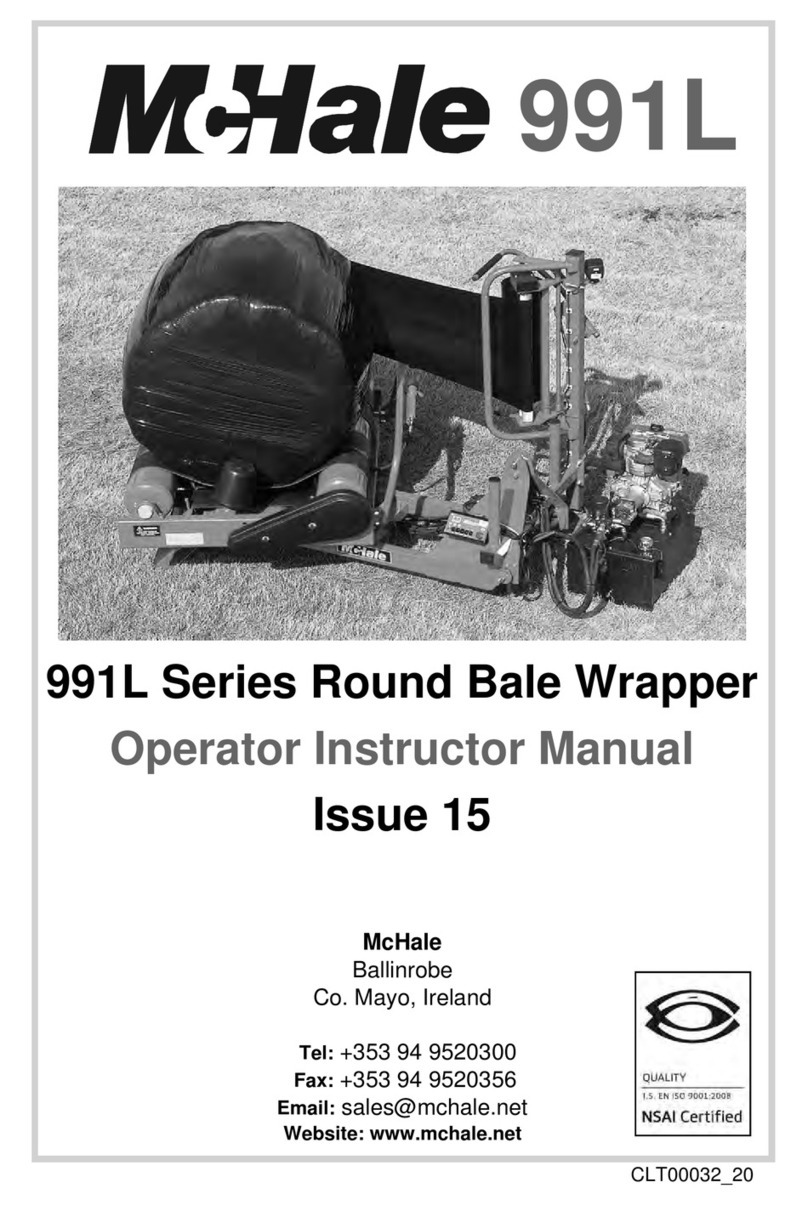
McHale
McHale 991L Series Operator Instructor Manual
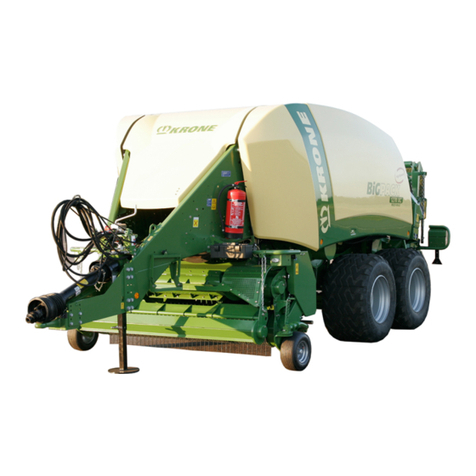
Krone
Krone Big Pack 1270 Original operating instructions
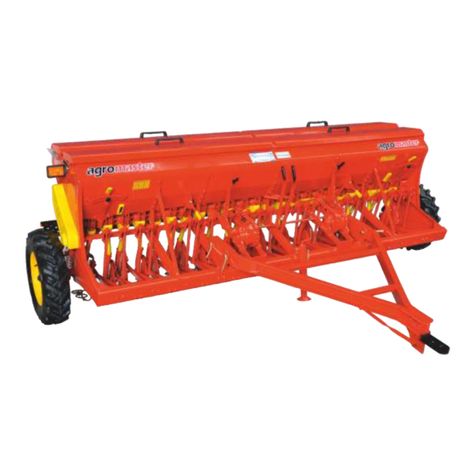
agromaster
agromaster BM Series OPERATOR'S MANUAL AND SPARE PARTS
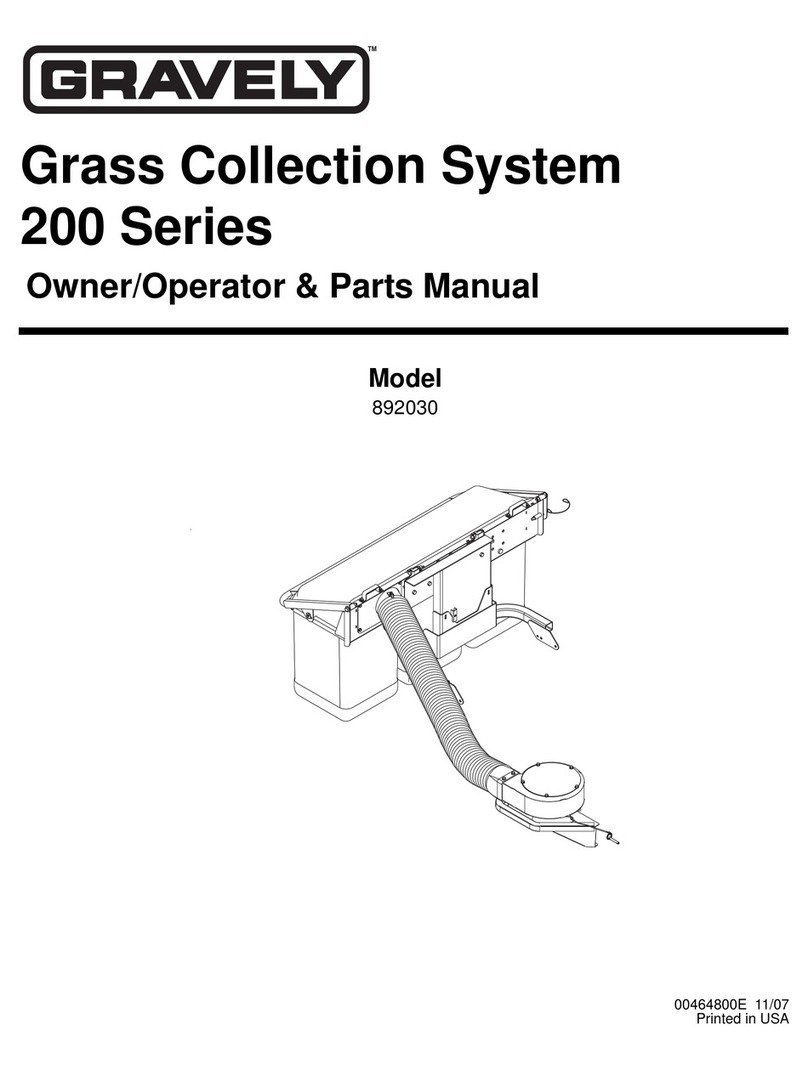
Gravely
Gravely 200 Series Owner/operator and parts manual
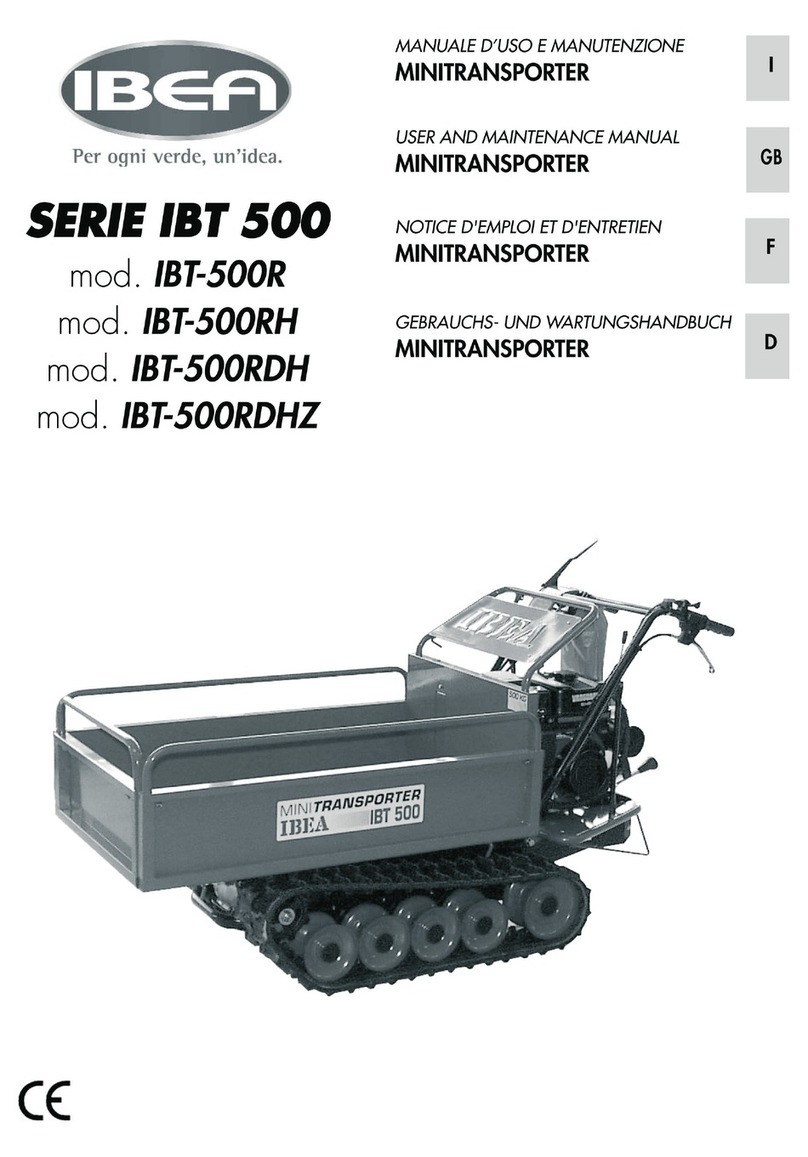
IBEA
IBEA IBT 500 Series User and maintenance manual
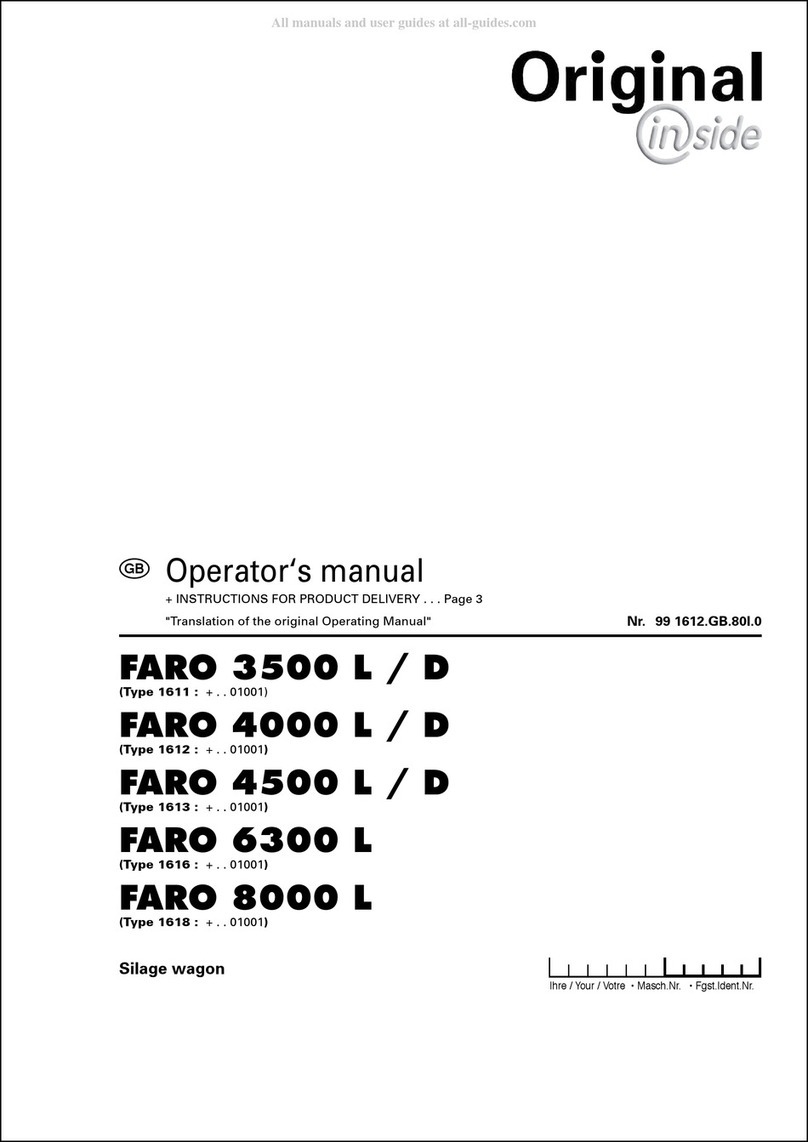
Original inside
Original inside FARO 3500 L/D Operator's manual
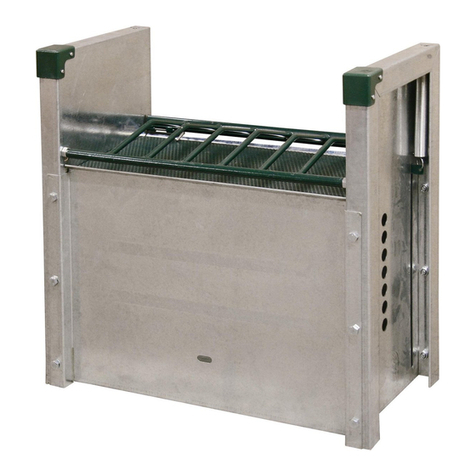
Kerbl
Kerbl horseGraze installation guide
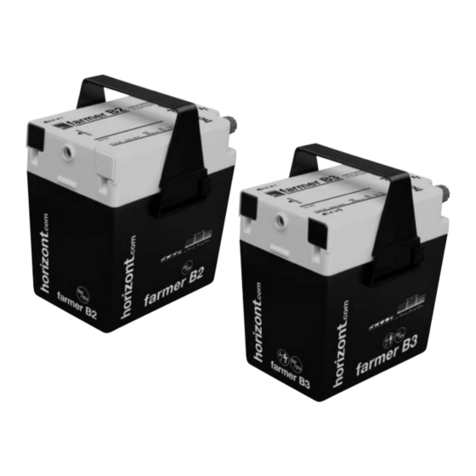
Horizont Agrar
Horizont Agrar farmer B2 Type 10441 Operating instruction

Brillion
Brillion Compaction Commander 03 Series Operator's manual
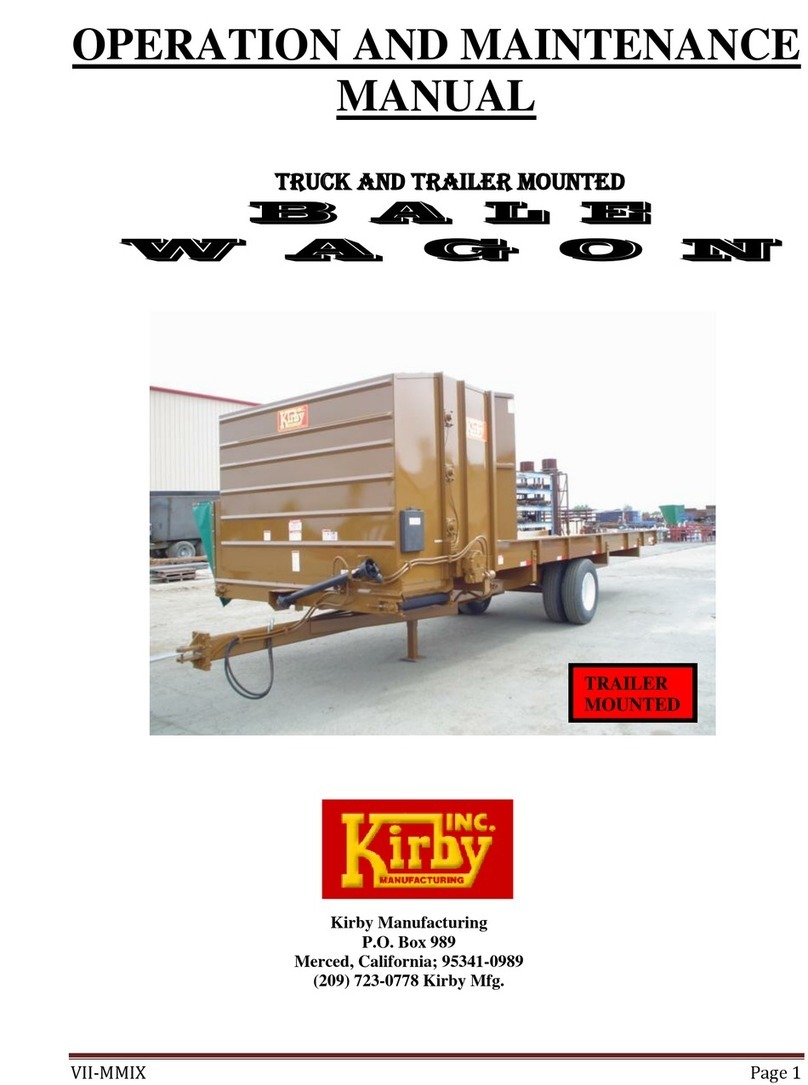
Kirby
Kirby Bale Wagon Operation and maintenance
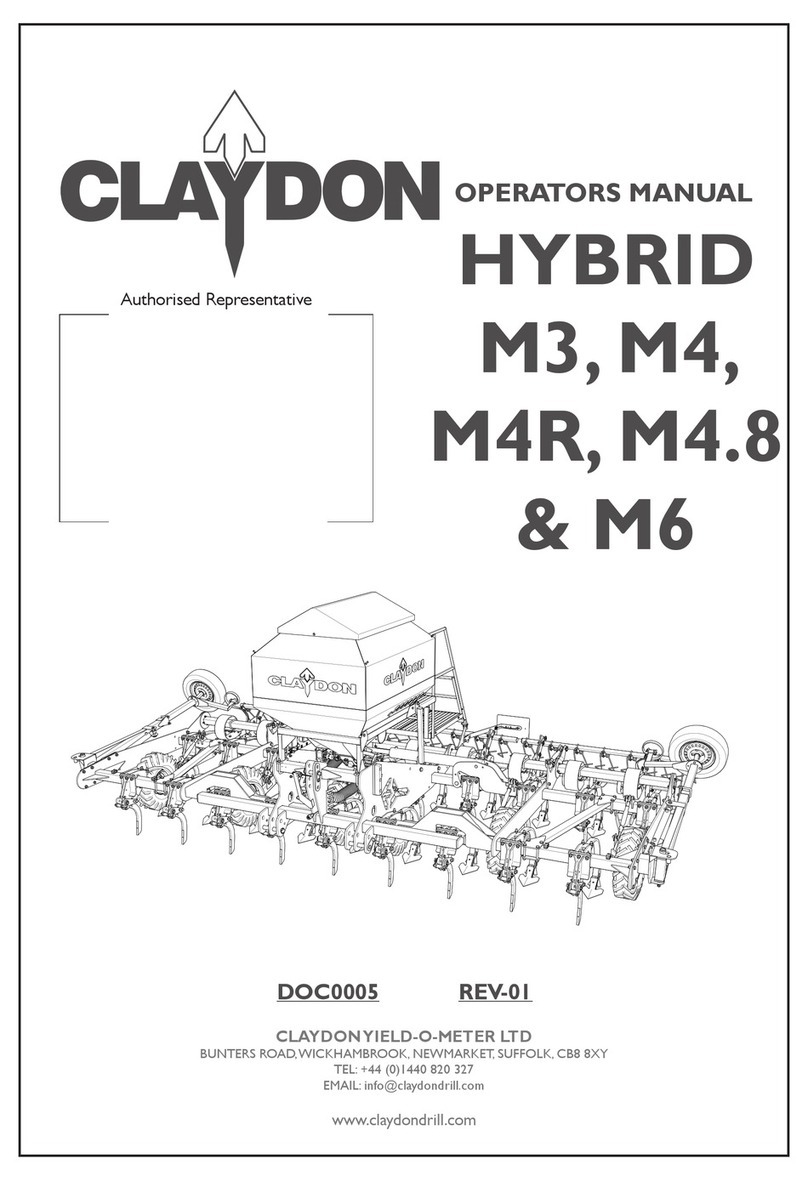
Claydon
Claydon HYBRID M3 Operator's manual
